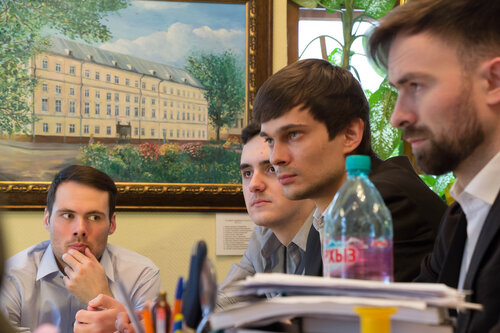–£–≤–∞–ґ–∞–µ–Љ—Л–µ –Ї–Њ–ї–ї–µ–≥–Є! –Я—А–µ–і—Б—В–∞–≤–ї—П—О –њ—А–Њ–µ–Ї—В —В–µ–Ї—Б—В–∞ –љ–Њ–≤–Њ—Б—В–Є –њ–Њ –Р–љ–≥–ї–Є–є—Б–Ї–Њ–Љ—Г –Ї–ї—Г–±—Г –љ–∞ —Б–∞–є—В —И–Ї–Њ–ї—Л –±–µ–Ј –Ї–∞—А—В–Є–љ–Ї–Є.
–Ю–±—А–∞–Ј–Њ–≤–∞–љ–Є–µ, –Ї–Њ—В–Њ—А–Њ–µ —Б–Њ–≤—А–µ–Љ–µ–љ–љ–Њ–µ –≥–Њ—Б—Г–і–∞—А—Б—В–≤–Њ –њ—А–µ–і–ї–∞–≥–∞–µ—В —Б–Њ–≤—А–µ–Љ–µ–љ–љ–Њ–Љ—Г —З–µ–ї–Њ–≤–µ–Ї—Г, —А–∞–Ј–і—А–Њ–±–ї–µ–љ–Њ –љ–∞ –Њ—В–і–µ–ї—М–љ—Л–µ —Г—З–µ–±–љ—Л–µ –њ—А–µ–і–Љ–µ—В—Л. –£—Б–њ–µ—И–љ–Њ —А–∞–±–Њ—В–∞–≤—И–Є–є –≤ –њ—А–Њ—И–ї–Њ–Љ, –≤ –љ–∞—Б—В–Њ—П—Й–µ–Љ —В–∞–Ї–Њ–є –њ–Њ–і—Е–Њ–і –љ–µ –Њ—В–≤–µ—З–∞–µ—В —В—А–µ–±–Њ–≤–∞–љ–Є—П–Љ –і–µ–є—Б—В–≤–Є—В–µ–ї—М–љ–Њ—Б—В–Є. –Т –Љ–Є—А–µ –љ–µ–Њ–њ—А–µ–і–µ–ї–µ–љ–љ–Њ—Б—В–Є, —Б–ї–Њ–ґ–љ–Њ—Б—В–Є –Є —А–∞–Ј–љ–Њ–Њ–±—А–∞–Ј–Є—П —З–µ–ї–Њ–≤–µ–Ї—Г –љ—Г–ґ–љ—Л —Ж–µ–ї–Њ—Б—В–љ–∞—П –Ї–∞—А—В–Є–љ–∞, —А–∞–Ј–љ–Њ–Њ–±—А–∞–Ј–љ—Л–є –љ–∞–±–Њ—А –Ј–љ–∞–љ–Є–є, –љ–∞–≤—Л–Ї–Њ–≤, —Г–Љ–µ–љ–Є–є –Є –Ї–Њ–Љ–њ–µ—В–µ–љ—В–љ–Њ—Б—В–µ–є. –†–µ—И–Є—В—М —Н—В—Г –Ј–∞–і–∞—З—Г –њ—А–Є–Ј–≤–∞–љ–∞ –Њ–±—А–∞–Ј–Њ–≤–∞—В–µ–ї—М–љ–∞—П —Д–Њ—А–Љ–∞, –Ї–Њ—В–Њ—А–∞—П –љ–∞–Ј—Л–≤–∞–µ—В—Б—П –Љ–µ—В–∞–њ—А–µ–і–Љ–µ—В, –≤—Л—Б—В—А–∞–Є–≤–∞–µ–Љ—Л–є –њ–Њ–≤–µ—А—Е —В—А–∞–і–Є—Ж–Є–Њ–љ–љ—Л—Е —Г—З–µ–±–љ—Л—Е –њ—А–µ–і–Љ–µ—В–Њ–≤.
–†–µ–Ј—Г–ї—М—В–∞—В–Њ–Љ –љ–∞—И–µ–є –њ–Њ—Б–ї–µ–і–љ–µ–є –Љ–µ—В–Њ–і–Є—З–µ—Б–Ї–Њ–є —А–∞–Ј—А–∞–±–Њ—В–Ї–Є –≤ –Њ–±–ї–∞—Б—В–Є –Љ–µ—В–∞–њ—А–µ–і–Љ–µ—В–љ–Њ–≥–Њ –њ–Њ–і—Е–Њ–і–∞ –Ї –Њ–±—А–∞–Ј–Њ–≤–∞–љ–Є—О —П–≤–ї—П–µ—В—Б—П —Г—З–µ–±–љ—Л–є –Ї—Г—А—Б –љ–∞ –∞–љ–≥–ї–Є–є—Б–Ї–Њ–Љ —П–Ј—Л–Ї–µ –њ–Њ–і –љ–∞–Ј–≤–∞–љ–Є–µ–Љ ¬ЂA LOOK AT RUSSIAN HISTORY. THE ROMANOVS¬ї.
–Я–Њ–і–≥–Њ—В–Њ–≤–ї–µ–љ–љ—Л–є –љ–∞ –Њ—Б–љ–Њ–≤–µ –Є—Б—В–Њ—А–Є—З–µ—Б–Ї–Њ–є –Ї–∞–љ–≤—Л –ґ–Є–Ј–љ–Є –і–Њ–Љ–∞ –†–Њ–Љ–∞–љ–Њ–≤—Л—Е, –љ–∞—Б—В–Њ—П—Й–Є–є —Г—З–µ–±–љ—Л–є –Ї—Г—А—Б –њ–Њ–Ј–≤–Њ–ї—П–µ—В —Г—З–∞—Й–µ–Љ—Г—Б—П –Њ–≤–ї–∞–і–µ—В—М –Ї–Њ–Љ–њ–µ—В–µ–љ—Ж–Є–µ–є –Ї–Њ–Љ–њ–ї–µ–Ї—Б–љ–Њ–≥–Њ –∞–љ–∞–ї–Є–Ј–∞ –Љ–∞—Б—Б–Є–≤–∞ –Є–љ—Д–Њ—А–Љ–∞—Ж–Є–Є (–∞–љ–≥–ї–Є–є—Б–Ї–Є–є —П–Ј—Л–Ї, –Є—Б—В–Њ—А–Є—П, –Є—Б—В–Њ—А–Є—П –Є—Б–Ї—Г—Б—Б—В–≤, –Њ—Б–љ–Њ–≤—Л –њ—А–∞–≤–∞ –Є —Н–Ї–Њ–љ–Њ–Љ–Є–Ї–Є, –њ–Њ–ї–Є—В–Њ–ї–Њ–≥–Є–Є, –њ—А–Є–Ї–ї–∞–і–љ–Њ–є –њ—Б–Є—Е–Њ–ї–Њ–≥–Є–Є, –Є—Б—В–Њ—А–Є–Є –љ–∞—Г–Ї–Є –Є —В–µ—Е–љ–Є–Ї–Є), –Є—Б–њ–Њ–ї—М–Ј—Г—П –њ—А–µ–і–≤–∞—А–Є—В–µ–ї—М–љ—Л–µ –њ—А–µ–і–Љ–µ—В–љ—Л–µ –Ј–љ–∞–љ–Є—П –і–ї—П —Б–Њ–Ј–і–∞–љ–Є—П –љ–Њ–≤—Л—Е –њ–Њ–љ—П—В–Є–є, –≤—Л—Е–Њ–і—П—Й–Є—Е –Ј–∞ —А–∞–Љ–Ї–Є —В—А–∞–і–Є—Ж–Є–Њ–љ–љ—Л—Е —Г—З–µ–±–љ—Л—Е –њ—А–µ–і–Љ–µ—В–Њ–≤, –≤ –Ї–Њ–љ–µ—З–љ–Њ–Љ –Є—В–Њ–≥–µ –Ї–Њ–љ—Б—В—А—Г–Є—А—Г—П —Ж–µ–ї–Њ—Б—В–љ—Г—О –Ї–∞—А—В–Є–љ—Г –Љ–Є—А–∞. –Ф—А—Г–≥–Є–Љ–Є —Б–ї–Њ–≤–∞–Љ–Є, –Ј–∞–і–∞—З–∞ –љ–∞—Б—В–Њ—П—Й–µ–≥–Њ –њ–Њ—Б–Њ–±–Є—П - –≤—Л—А–∞–±–Њ—В–∞—В—М —Г —Г—З–∞—Й–µ–≥–Њ—Б—П –љ–µ–Њ–±—Е–Њ–і–Є–Љ—Л–є –љ–∞–±–Њ—А —Г–Љ–µ–љ–Є–є –Є –љ–∞–≤—Л–Ї–Њ–≤, –њ–Њ–Ј–≤–Њ–ї—П—О—Й–Є—Е –µ–Љ—Г —Н—Д—Д–µ–Ї—В–Є–≤–љ–Њ –∞–љ–∞–ї–Є–Ј–Є—А–Њ–≤–∞—В—М –ї—О–±—Г—О —А–∞–Ј–љ–Њ–њ—А–µ–і–Љ–µ—В–љ—Г—О –Є –Є–љ–Њ—П–Ј—Л—З–љ—Г—О –Є–љ—Д–Њ—А–Љ–∞—Ж–Є—О, —Б–Њ–Ј–і–∞–≤–∞—П —Ж–µ–ї–Њ—Б—В–љ—Л–є –Њ–±—А–∞–Ј –Њ–±—К–µ–Ї—В–∞, —Б–Њ–±—Л—В–Є—П, –њ—А–Њ–±–ї–µ–Љ—Л –Є–ї–Є —П–≤–ї–µ–љ–Є—П –Є –њ–Њ –Є—В–Њ–≥–∞–Љ –∞–љ–∞–ї–Є–Ј–∞ –њ—А–Є–љ–Є–Љ–∞—В—М –≤–µ—А–љ–Њ–µ —А–µ—И–µ–љ–Є–µ.





